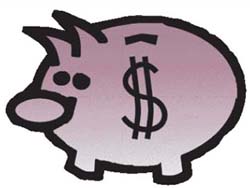 |
 |
| current issue |  | past issues |  | send a letter/news |  | address update |  | advertise |  | about us |  | alumni home |
| Spring 2009 |

|
| Departments |

|
| Alumni News |
| Alumni Profiles |
| Book Reviews |
| Campus Currents |
| Class Notes |
| Features |
| History Page |
| Letters to the Editor |
| Obituaries |
| President's Column |
| Question/Answer |
| University Research |

|
| Department Archives |
| Table of Contents |
|
Search UNH Magazine: |
Features
Sticker ShockPage 3 of 5
So, in spite of tuition increases, UNH is still a good value for New Hampshire students. It would be hard for them to go to a public university in another state or any good private college for what they pay at their own highly regarded state university. The question is: can it remain a good value? David Proulx '92, '00G, UNH assistant vice president for financial planning and budget, estimates that in 10 years, assuming 5 percent annual increases, in-state students will pay $33,000 and out-of-state will pay $55,000 per year. "We need to work hard to curb these increases, as we are reaching a break point for our nonresident students and perhaps our resident students," he observes.

|
Of course, the prices published in college catalogues and directories donat tell you everything you need to know to make a realistic comparison of the true cost for any given student. Published prices are discounted substantially through financial aid programs at both public and private institutions. The College Board reports that some $143 billion in financial aid was distributed to undergraduate and graduate students throughout the United States in the 2008-2009 academic year in the form of grants, subsidized loans, federal work-study assistance, and federal tax credits and deductions.
The availability of financial aidaparticularly in the form of scholarships and grants, which donat have to be repaidais often a major consideration for a high school senior who has been accepted at several colleges. At UNH, 82 percent of full-time undergraduate students received financial aid last year, including 59 percent who received institutional grants, with the average financial-aid package amounting to $17,910.
Increasing the amount of financial aid available to students who need it has been a priority at UNH for many years. Since 2000, the university system has more than tripled financial aid for New Hampshire residents at all of its campuses. UNH now provides some $25 million in need-based institutional grants every year, in addition to the assistance students receive from other sources. Add in institutional grants that are merit-based or talent-based, including athletic scholarships, and the university's total budget for financial aid is more than $40 million a year. But the need is still growing faster than the university's ability to meet it. One result is that students are accumulating increasing burdens of debt. About 75 percent of this yearas graduates borrowed money for college. They left with their diplomas and an average debt of more than $27,500.
So far, student application and enrollment figures at UNH have shown steady upward growth, in spite of the rising cost of attendance and the dismal economy. Applications for the coming academic year nearly matched the record high set last year, and the number of admitted students who sent in deposits exceeded expectations at a time when many other colleges are reporting fiat or declining rates of deposit. This is a strong indication that prospective students still find UNH to be a good choice and one that they can afford.
But university officials are very concerned about something Huddleston calls "the wedge." He explains it like this: "Imagine a simple graph, one that displays two rising cost curves. One is the moderately upward trend that shows what the median family income is going to look like in the next 10 to 15 years. The other line rises much more sharply, projecting the cost of higher education." The increasing gap between the two—the wedge—is alarming. "We need to provide substantially more endowed student aid to hold down the differential between those two lines on the graph," Huddleston says,
The Limits of Frugality
There are only two ways to rein in the rising cost of tuition. The first is to decrease expenses, and the second is to increase revenue from sources other than tuition. UNH has been striving mightily to do both.
Teaching, research and public service—the three components of the university's mission—are all labor-intensive endeavors, so it is not surprising that salaries and benefits for faculty and staff account for about 63 percent of UNH's total expenses. Faculty salaries at all levels (professor, associate professor and assistant professor) fall in the middle range for comparable institutions, neither near the bottom nor the top of the scale, according to a recent American Association of University Professors survey.
Page: 1 2 3 4 5 < Previous Next >
Easy to print version